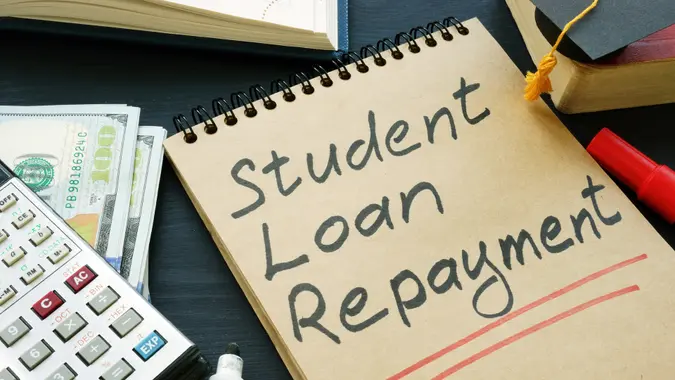How To Pay Down Your Student Loan Debt With Crypto

Commitment to Our Readers
GOBankingRates' editorial team is committed to bringing you unbiased reviews and information. We use data-driven methodologies to evaluate financial products and services - our reviews and ratings are not influenced by advertisers. You can read more about our editorial guidelines and our products and services review methodology.

20 Years
Helping You Live Richer

Reviewed
by Experts

Trusted by
Millions of Readers
Student loans have become a massive burden for millions of Americans. As of 2024, nearly 43 million borrowers owe a total of $1.77 trillion in student loans, with the majority being federal loans.
While traditional methods of repaying student loans involve using your income to make monthly payments, you can also use crypto to tackle debt. Here are two ways to pay down student loan debt with crypto.
Next, find out how you can pay your bills with cryptocurrency.
Take Out a DeFi Loan
DeFi, or decentralized finance, is a financial service that runs on blockchain networks, like ethereum (ETH). Unlike traditional banks, DeFi platforms don’t rely on human approval. Instead, they use smart contracts to let people borrow, lend or earn interest on their digital assets.
So, how do DeFi loans work? Say you have $15,000 in student loan debt and own $30,000 worth of ETH. Since you don’t want to sell your ETH because you think the price will go up over time, you can use a DeFi platform like Aave or MakerDAO to deposit your ETH as collateral and borrow $15,000 in stablecoins.
You can then convert the stablecoins into U.S. dollars and pay off your student loan debt. Once you repay the borrowed amount plus the interest, you get your ETH back.
However, most DeFi platforms will only let you borrow 50% to 70% of your collateral’s value. This is called the Loan-to-Value (LTV) ratio. If the value of your crypto drops significantly, you may be liquidated, meaning the platform sells part of your digital asset to cover the loan.
Pros
- Lower interest rates: The first thing that makes DeFi loans attractive is the low interest rates and flexible repayment schedules. In some cases, borrowing rates are near zero.
- No credit score required: Since these loans are issued via smart contracts and not by financial institutions, you don’t need to have a good credit score. Your crypto acts as the collateral instead of your credit history.
Cons
While using DeFi loans to pay down student loans has advantages, it’s not without risks.
- Liquidation risk: If the value of your crypto drops too low, the platform could sell part or all of it to cover the loan.
- Variable interest rates: The variable interest rates can spike during periods of high demand, making borrowing more expensive.
- Smart contract risk: Since smart contracts are codes that are vulnerable to bugs, your collateral is at risk.
Use a Third-Party Platform
If you own digital assets, you can use a third-party platform, like BitPay to pay bills using crypto. All you need to do is download the app and create a wallet.
Once your account is active, link your student loan account directly to the platform. From there, select the loan you want to pay and choose the cryptocurrency you’d like to use. BitPay will then convert your crypto into cash and send the payment directly to your lender.
You can use BitPay to make student loan payments from virtually any lender, including Sallie Mae, Navient, Nelnet and FedLoan Service, among others. Plus, the platform accepts dozens of cryptocurrencies, such as bitcoin, ethereum, dogecoin, bitcoin cash and many more.
Unlike DeFi loans, where you get back your crypto after repaying the borrowed amount, with this option, you’ll lose your digital assets. So, if you anticipate a value increase in the future, taking a DeFi loan might be a better option.
More From GOBankingRates
Sources
 Written by
Written by  Edited by
Edited by 
























